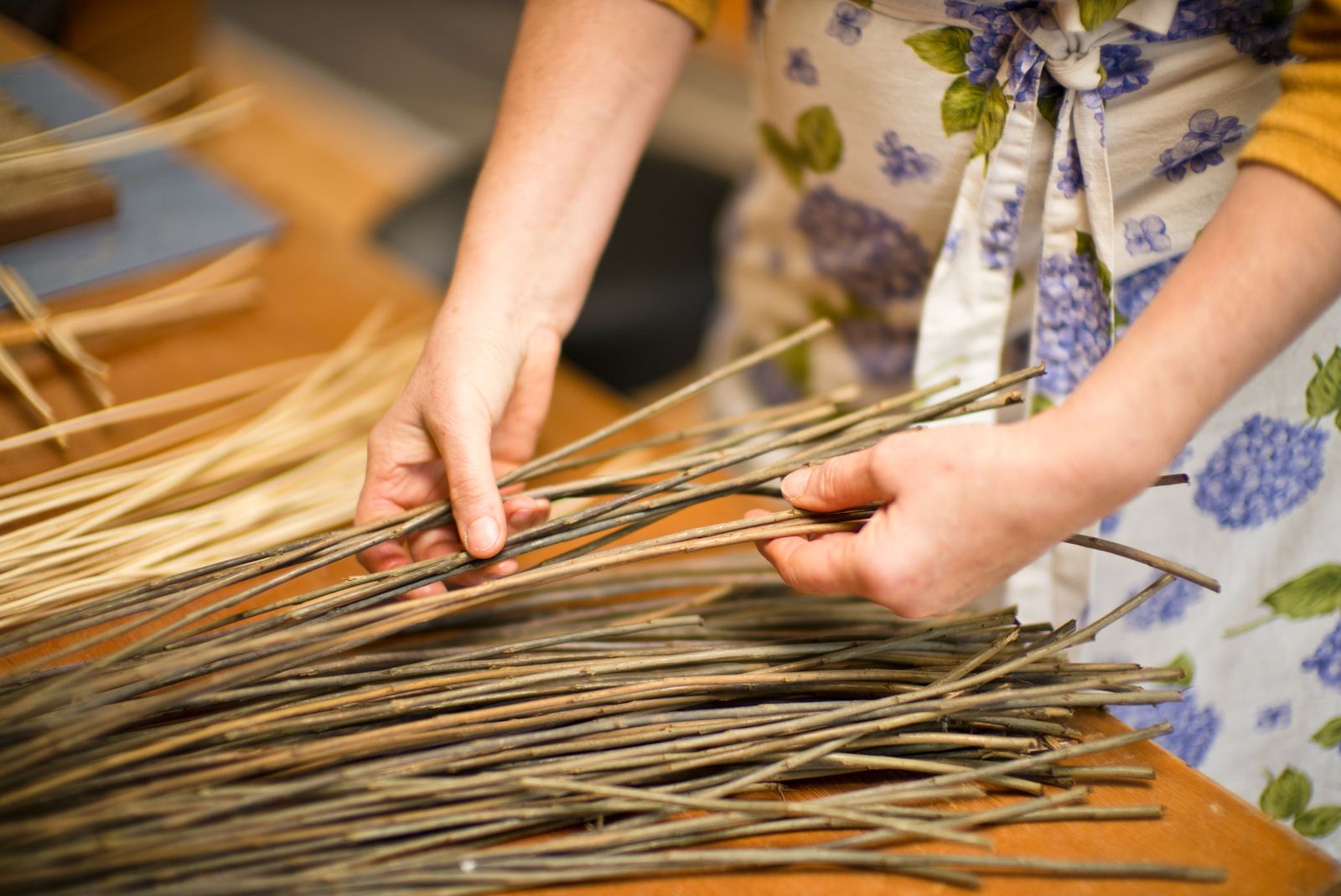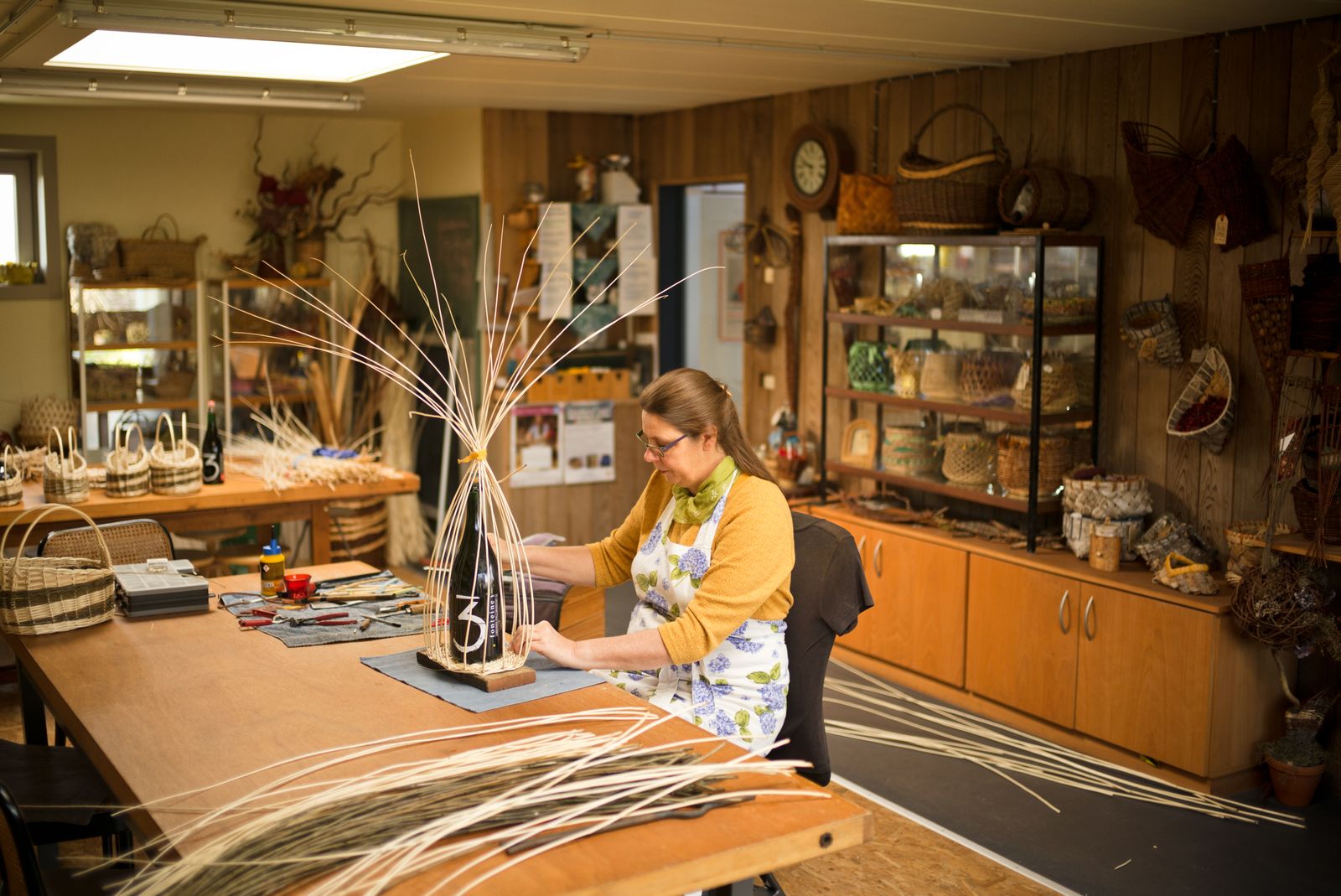Pouring lambic is an art. There are rules, which luckily come with helpful tools. A pouring basket, for instance, which keeps the bottle horizontal so the lees remain where they lie: at the bottom. The baskets from which we slowly pour lambic beer are woven in Gerda Legrand’s workshop, using only hands, twigs and love.
When she’s on the topic of willows, Gerda gets all excited. She even works the Greeks and the Romans into the conversation. “They were already crossing plants in search of the perfect weaving willow. They would plant these in rows, one closely following the next, adding pole sticks in the ground.” It’s still done this way today with willow shoots. After a year, the young shoots are mown, then dried before being dexterously turned into baskets.
Gerda knows that pollard willows are no good for weaving, that the perfect tree has zero side branches and that there are over 500 species of willow. “Willow branches originally came from Belgium,” she continues her exposé. “They grow where they find water, like next to the river Scheldt.” But that was then. Today, Belgian wicker growers have all but disappeared. “There is one breeder left in our country, but he exports all his shoots abroad, mostly to Japan. The quality of the Belgian red willow is still by far the best, but all basket makers in these parts have long gone.”

Vacuum cleaners are the new brooms.
Historically speaking, the area around Zingem used to be the Mecca of basketry—until the 1930s happened. “Labourers revolted against the heavy manual labour, organising themselves in trade unions. Meanwhile, the US and Great Britain raised their import duties. As a result, the number of orders dwindled. Wicker traders had no choice but to export their finest material to other countries. What remained were inferior twigs.” After World War II, shades of pastel and cries of prosperity flooded the markets. Video killed the radio star, and plastics meant the demise of the basket industry in the region. “Vacuum cleaners became the new brooms and carpet beaters were suddenly made out of plastic.”
Once, I was asked for a demonstration out on the street, wearing this silly old garb. There I stood, crammed between a market stall selling sausages and another one with take-away wok dishes.
And then there’s Gerda, a bit of an anachronism, peeling willow shoots in her back yard and single-handedly taking on an industry that shifted to Indonesia and beyond. “In Belgium, basketry has become somewhat of a living museum,” she laughs. “Once, I was asked for a demonstration out on the street, wearing this silly old garb. There I stood, crammed between a market stall selling sausages and another one with take-away wok dishes. I took off my apron, walked into a café and said: ‘Give me the strongest beer you have.’ Afterwards, they asked me to set up shop at that same market again. This time, they wanted me for two days, but for the price of one,” Gerda says, looking surly. “Do I look like a discount supermarket?”
On the contrary. Gerda would like to shed this image of mouldy old-fashioned ness that seems to be synonymous with basketry. “I want to take weaving to a higher level and create something new, using an old craft. I want to move forward, looking for new techniques as I go.” And so she makes fine jewellery out of golden straw as delicate as gossamer, folds discarded phone books into baskets and plans trips to Denmark to expand on her arsenal of techniques.

On the beauty of imperfection.
In Gerda’s workshop, you’ll never spot the same item twice. That’s because Gerda’s always looking for some challenge, but also because the material dictates the result. “I don’t use any moulds. Plus, no two willow shoots are alike.” They differ in shape and thickness, even in shade. “Once harvested on the field, the twigs are knotted in a bundle to dry. That’s why the inside of the bundle is a bit darker than the outside, which bleaches in the sun. However well you try to weave and sort your shoots according to colour and length, imperfection will be part of the product.”
But imperfection might just be what makes the whole thing so beautiful. Gerda: “These shoots take their time to grow. It’s the same with 3 Fonteinen’s beer: it needs time to develop its taste and to mature.” Making a basket takes Gerda about two or three hours, not counting any of the preparations. “In November, the shoots are harvested and sorted according to size. Then they’re laid out to dry for a year. Willow tends to drink a lot during its lifetime and expands quite a bit. While drying, this water evaporates and the twigs shrink to half their size. If I would use fresh twigs to weave, the basket would dry and fall apart after six months.”
However well you try to weave and sort your shoots according to colour and length, imperfection will be part of the product.
To make a basket for a bottle of geuze, Gerda needs only a bundle of shoots, some gear and a 3 Fonteinen magnum bottle. Not to drink, just to park its weight straight atop the basket’s slath, keeping it in place. First, she sorts her shoots. “The thick ones for spokes, the skinnier ones for weavers. The latter are bathed in water for two weeks before I start weaving. The heart of the twigs needs to be pliable enough, which is why you need to soak them again after they’ve dried for a year.”
The baskets Gerda weaves for Brouwerij 3 Fonteinen are white and green. Actually, she only uses one kind of shoots: the green ones. “The shoots are white once you peel them.” In her garden, Gerda has set up a peeling iron: two rods, tightly clamped together. She pulls each shoot through the device, which scrapes off its bark, leaving it bare and white. “There are semi-automatic ways to do this now, but once upon a time, this was a chore for the children. They had to peel a bunch before being allowed to go to school.” She strips shoot after shoot with a brightly resounding ‘zinggg’.
Once the whole bundle has shed its skin, Gerda moves her material to the work table. In a few movements, she puts together the basket base, in which she inserts spokes by wiggling them in with an awl. The basket now looks like a sun with sprawling rays, which she skillfully keeps in check. “These will form the sides of the basket,” Gerda explains. Once she’s finished weaving upwards, she ends in a diagonal line, adds a trim and two nicely arched handles.
Thou shalt not weave with reed.
Gerda is formal: reed is no use for weaving. “You can use many materials, but not reed. It’s a very rigid water plant which doesn’t bend well.” What is being used, however, is pith reed. “In the ’60s, pith reed was used a lot for weaving. The name is confusing: while we call it reed, it is actually the core of the long stalks of rattan.” Gerda got quite tired of having to explain the difference to people mixing up the jargon. “I ended up turning my grievances into a lecture,” she says.
This lecture about reed, pretend-reed, wicker and willows was the result of a bit of frustration, a great deal of love, and a financial reality. “I can’t live off baskets alone,” Gerda says. And so she teaches about 80 per cent of the time. “This urge to teach is part of me. Call it a calling, if you will.”
I don’t have any colleagues to ask for advice, so I went to look online. A lot of watching, followed by ten attempts to make just one chair.
Today, besides lecturing, Gerda also teaches people with disabilities. “I organise workshops for the Braille League and find them very satisfying. Blind people are better listeners. Others start weaving while the teacher is still busy explaining. They don’t. They wait, they listen, and then they get cracking.”
Gerda herself learned the tricks of her trade off YouTube. “I don’t have any colleagues to ask for advice,” she says, “so I went to look online. A lot of watching, followed by ten attempts to make just one chair. There are a few books on the subject and I’ve read them. I’ve had classes with a German and a Swede. But there isn’t much teaching material out there.” Not that that would stop Gerda. “I’m a weaver”, she says. And as a weaver, she weaves.